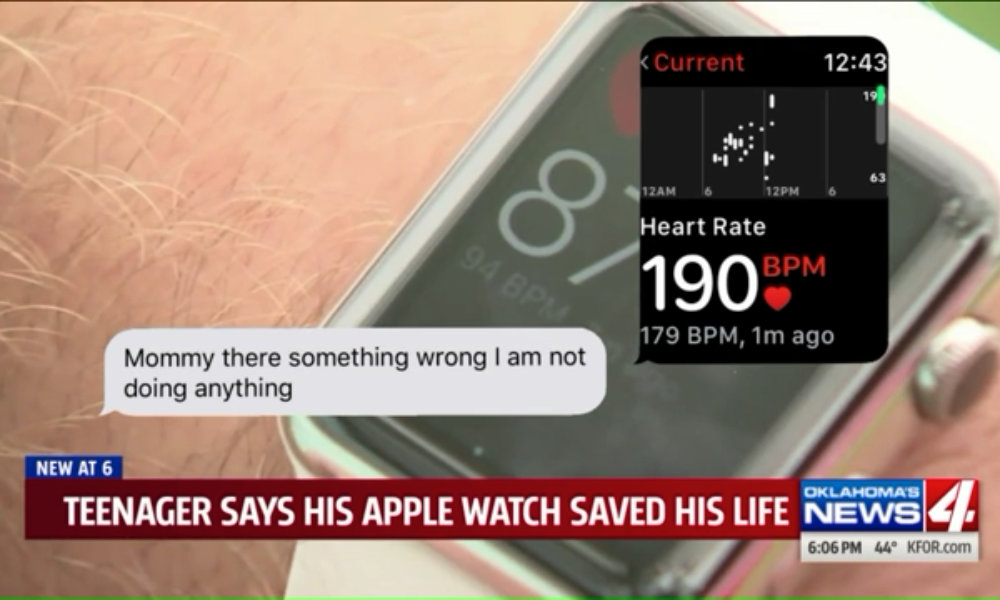The Apple Watch Saved This Teenage Football Player’s Life
 Credit: KFOR News 4
Credit: KFOR News 4
Toggle Dark Mode
These days it seems like barely a month goes by that we don’t hear of an Apple Watch helping to alert users of potentially deadly medical conditions, and it’s clear that Tim Cook’s desire for Apple to leave a legacy of contributions to healthcare and bettering people’s lives is bearing fruit in the Apple Watch alone.
Ultimately, however, one of the real values in the stories of how the Apple Watch is working to alert users to serious medical conditions is letting others know how much of a difference a wearable device that is still seen by many as a mere gadget for techies and hardcore fitness enthusiasts can make a difference for a lot of other people as well.
In the latest case, a woman in Oklahoma has shared the story of how the Apple Watch alerted her son to an extremely serious medical condition that would have likely gone undetected and undiagnosed without Apple’s wearable device.
As reported by Oklahoma’s KFOR News 4, Skylar Joslin, a healthy and athletic 13-year-old teenager was having a normal day at school back in April 2018 when his brand new Apple Watch suddenly alerted him to a rapidly accelerating heart rate — over 190 beats per minute.
Skylar sent a text message to his mom, Liz, along with a screenshot of the alarmingly high heart rate, saying “Mommy, there’s something wrong. I’m not doing anything.”
Liz Joslin immediately rushed to Skylar’s middle school to pick him up, and took him to the local hospital emergency room about 14 minutes away. By the time they had arrived at the hospital, Skylar’s heart rate had reached 202 BPM, and after doctors admitted him to the hospital, he was eventually diagnosed with Supraventricular Tachycardia, or SVT, a disease that forces the heart to speed up and can weaken it over a period of time.
Heart Rate Hits 280
While Skylar was in the hospital, cardiologists reported that his heart rate peaked up to a staggering 280 BPM, requiring him to undergo a cardiac ablation — a seven-and-a-half-hour surgery that was required to fix his runaway heart rhythm.
Skylar took several months to recover from the surgery, and while he was back on the sports field not long after, he’s had to wear heart monitoring equipment and be closely monitored until he undergoes some additional procedures.
Like many of the heart-related conditions that are brought to light by the Apple Watch, what’s especially significant about this is that neither Skylar nor the Joslin family had any idea that the teen had a heart condition, and this could have gone undiagnosed and undetected for years had it not been for the Apple Watch.
The Joslin family expressed their amazement that buying their teenage son an Apple Watch had actually changed their lives, and it’s also led Skylar to share the experience with others in order to raise heart health awareness.
If I wouldn’t have gotten his Apple Watch, I don’t know that I would’ve ever known. I mean it’s unknown how long it would’ve been going on or how long it would’ve really taken.
Liz Joslin
Although Apple has been routinely adding more advanced heart and other health monitoring features to its more recent Apple Watch models, you don’t need the latest model of the Apple Watch to benefit from its life-saving features. The news report doesn’t say which model of the Apple Watch Skylar was wearing, but it didn’t need to be the newest (at the time) ECG-enabled Apple Watch Series 4 — every Apple Watch back to the Series 1 and watchOS 3 can offer the ability to notify users of both abnormally high and abnormally low heart rates.







